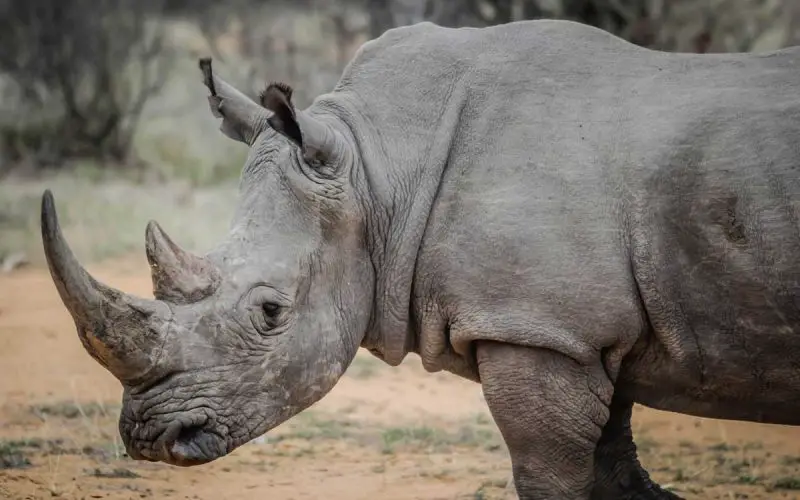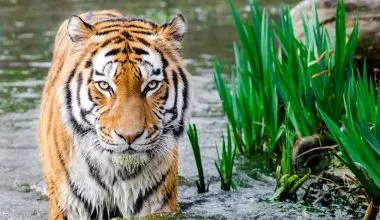Table of Contents Show
What are Rhinos?
The Rhinoceros, also known as Rhinos, are one of the largest terrestrial (land-based) animals on this planet. The word “rhinoceros” is derived by joining two Greek words, “rhino” (nose) and “ceros” (horn).
Ironically, the word “ceros”, that is often removed to condense the name, is the major reason we are talking about these herbivores being endangered today.
Rhinos are part of the Big Five game animals, weighing more than 1000 kilograms!
There are only 5 species of rhinoceros, with three of them being found in Africa and other two in various parts of Asia. There are also 11 sub-species. All of these species have either 1 or 2 horns on their noses.
All species are on the list of extremely endangered species. Unfortunately, some species have less than 50 individuals left.
Fossil records of Rhinos have been found dating back to the time right after the extinction of dinosaurs. For your information, those ancestors did not look like the modern day Rhinos but they were spread throughout the planet and had immense biodiversity.
Rhino ancestors (woolly rhino) went into extinction 14,000 years ago! This was most likely due to climate change.
There are few factors that have played a vital role in the rapid diminishing numbers of the species. If these factors are not stopped, they are sure to result in extinction of rhinos.
11 Interesting Facts about Rhinos
Fact No.1: They’re Heavy
Smallest Sumatran Rhinos weigh as much as 600Kgs. White Rhinos, largest of the Rhino species, can weigh up to 3500 Kilograms. That’s more than 3.5 tonnes! Imagine gaining that much weight only by eating grass and leaves.
Fact No. 2: Great Runners!
Rhinos can run at speeds of more than 30 miles per hour! Considering their weight, this is impressive!
Fact No.3: White or Black? It’s actually Grey.
Both Black and White Rhinos are of the same color; grey. The white rhinos actually got their name from Afrikaans calling it ‘wyd’. This is because they differentiated white rhinos with wide square upper lip from black rhinos which had a pointy upper lip.
Early English explorers misunderstood that word for ‘white’ and it stuck. Consequently, they named them as ‘black’ and ‘white’ rhino to differentiate.
Fact No. 4: Rhinos hear much better than they can see!
Rhinos are pretty much lost when it comes to eyesight. They can’t even visualize a person standing at a 30m distance from them.
However, they make up for it with their incredible hearing capability and sense of smell.
Fact No.5: Rhinos live up to 50 years!
Rhinos have an amazing life expectancy of 50 years. White rhinos get lucky and live around 40-50 years whereas Black rhinos live between 35-50 years. Indian rhinoceros lives up to 35 and 45 years.
Fact No.6: Rhinos Stay in mother’s womb for 16 months.
Rhinos have a gestational age of 16 months before they are born. In addition, Female rhinos can take up to 5 years to become mature.
Fact No. 7: Male Rhinos are ‘bulls’ whereas female rhinos are ‘cows’.
Male rhinos are bulls and female rhinos are known as cows. Their young offspring are called ‘calves’. Females are more likely to be in pairs and be social, in contrast to solitary males.
Together, a group of rhinos is called a ‘crash’.
Fact No. 8: Rhino’s horn and your fingernails are made from the same material!
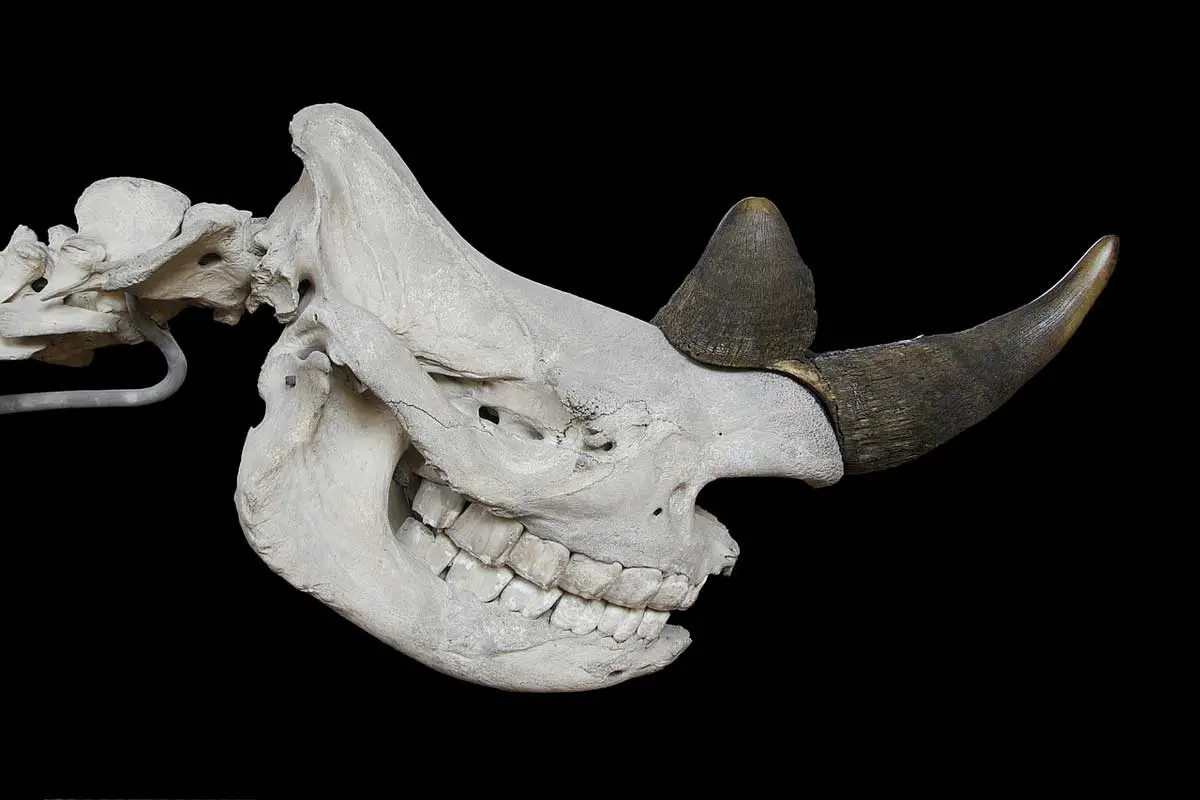
Rhino horns are made of Keratin. Keratin is actually the base compound present in our hair and nails. Only Javan and one-horned rhinos have a single horn, rest of rhinos species have 2.
Their horns continue to grow until they stay alive. White Rhinos increase their horn length by 7cm every year. Record length of a rhino’s horn is 150cm!
Fact No. 9: Rhinos mainly found in Africa and South Asia
Rhinos are found and poached in Africa and South Asia. African rhino numbers were as high as 500,000 at the beginning of 20th century. Today, Rhino population stands below 29,000 across the world.
This is mainly due to poaching and habitat loss.
Fact No. 10: Rhinos love to play in mud!
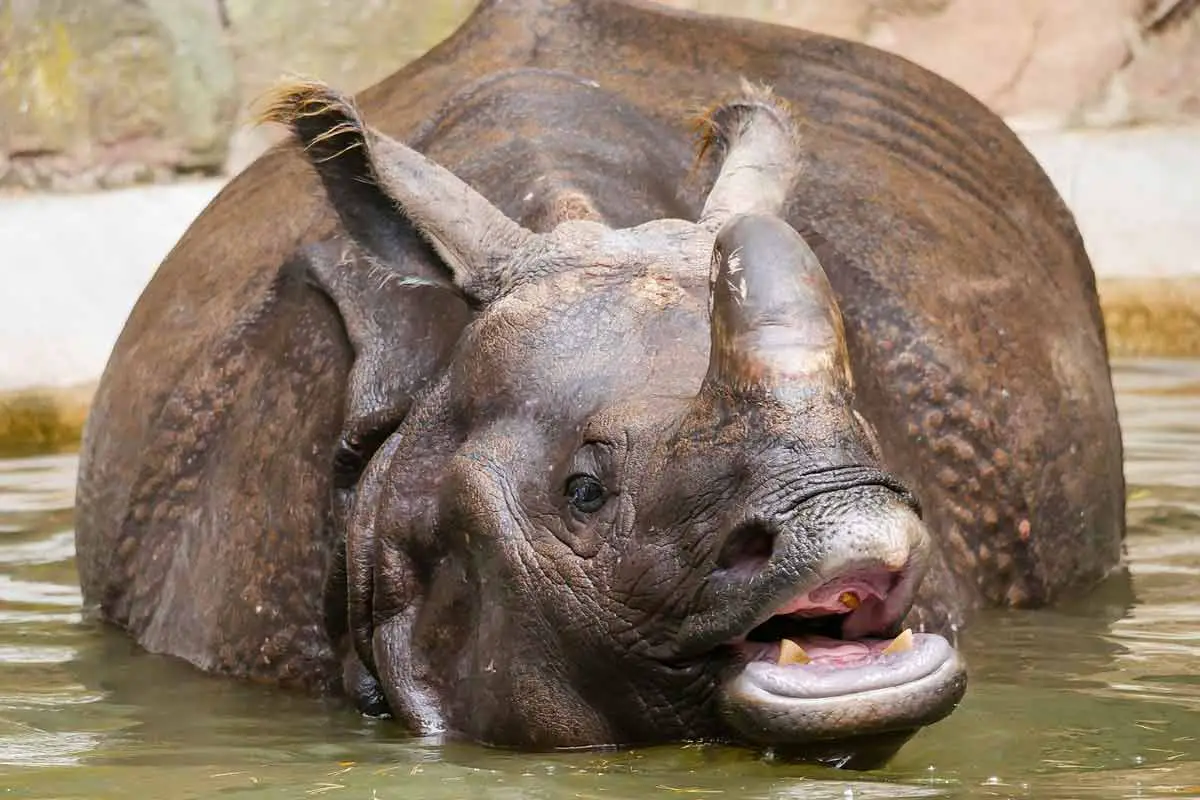
Rhinos can often be observed playing in the mud. They love to cover up themselves in mud. The ‘mud coat’ allows them to keep cool and protects against biting insects and various parasites.
Asian Rhinos are brilliant swimmers and are more often found in lakes and deeper waters. Their African cousins are poor swimmers and stick to shallow waters with mud to keep them cool.
Fact No.11: [Most Important]: Rhinos are critically endangered!
Hunting has taken lives of 7100 rhinos over the past decade. That’s as much as 2 rhinos every day!
Due to very high demand and extremely limited supply, rhino horns are sold at exorbitant prices. This has highly increased funding of hunters, allowing them to become much more sophisticated at hunting.
Sometimes, helicopters are used to locate rhinos. They’d shoot the rhino down from the sky, with guns or tranquilizers. Soon after, hunters land and quickly remove the rhino’s horns using chainsaws and fly away. The whole ordeal takes no more than 10 minutes, leaving the rhino dead or extremely injured.
Extremely injured rhinos bleeding from their head (due to horn removal) rarely survive.
Processed (ground) Rhino horn is used in traditional Asian medicine to cure a number of diseases, ranging from different cancers to hangovers. In some societies of Vietnam, possession of rhino horns is considered as a status symbol.
Among other threats to rhinos, Habitat loss and Fragmentation is a major threat as growing populations and infrastructure continue encroachment of their habitat.
Importance of Rhinos
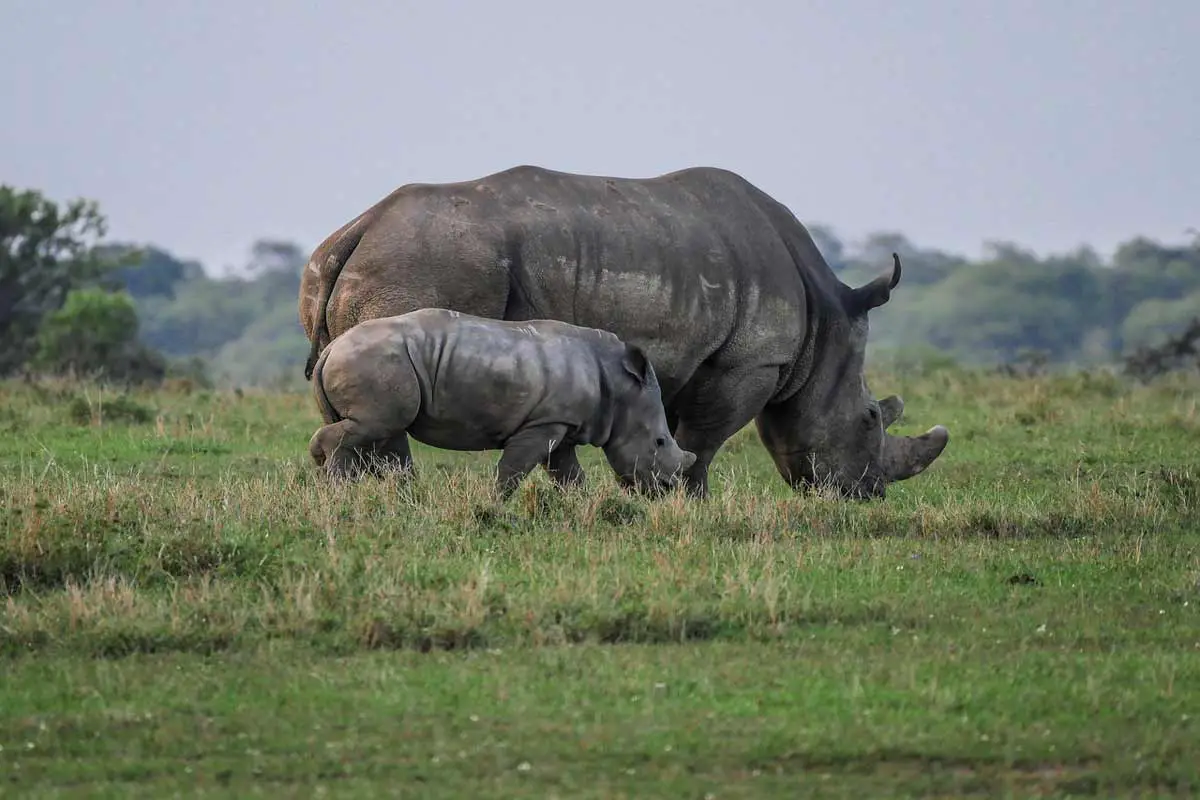
1. Vital to Ecosystems
Rhinos are often referred to as Umbrella or Keystone species. Such species play a greater role in maintenance of the ecosystem than other members. They’ve played this important role in ecosystems for millions of years.
Rhinos eat large amounts of leafy greens and vegetation, keeping their numbers in check. This also shapes up African landscapes.
In addition, this encourages a healthy competition with elephants and buffalo, maintaining their balance as well.
Rhino extinction could trigger a trophic cascade!
2. Habitat Protection
With habitat conservation efforts for the African rhinos, we are simultaneously protecting habitats of millions of other organisms.
This protection will go a long way in securing the livelihood of local communities that survive on the tourism industry. Before I forget to mention, Rhinos are a major tourist attraction and generate huge amounts of revenue for African countries.
We are protecting the future of local communities by ensuring rhino presence for future generations.
3. Tourist Attraction
Rhinos are a part of Africa’s ‘Big Five’ game animals. The magnificent beasts are some of the widely toured animals of the world. Tourists (like me) and locals love to visit parks and rhino habitats to see them.
Hopefully, I’ll get to see them once again before poaching removes them from Earth.
Anyways, these visits contribute to local and national economy of the country. This also make rhinos a source of sustainable income for the locals.
Where are rhinos found? Where do they live?
As discussed, there are 5 species of Rhinoceros. Two of those species are found in Africa whereas three of them are found in Asia.
Knowing where rhinos live will also help you understand where poaching happens if you choose to do something about it.
P.S: Some governments have stopped disclosing locations of Rhinos in order to protect them from poachers!
The White Rhinoceros
The White Rhinoceros is not actually white; it’s grey! Basically, Africans used to call them ‘wyd’ because of White Rhino’s wide square upper lip. English explorers picked up on it and started calling them ‘white’ rhinos to differentiate them from the pointy-lipped black rhinos.
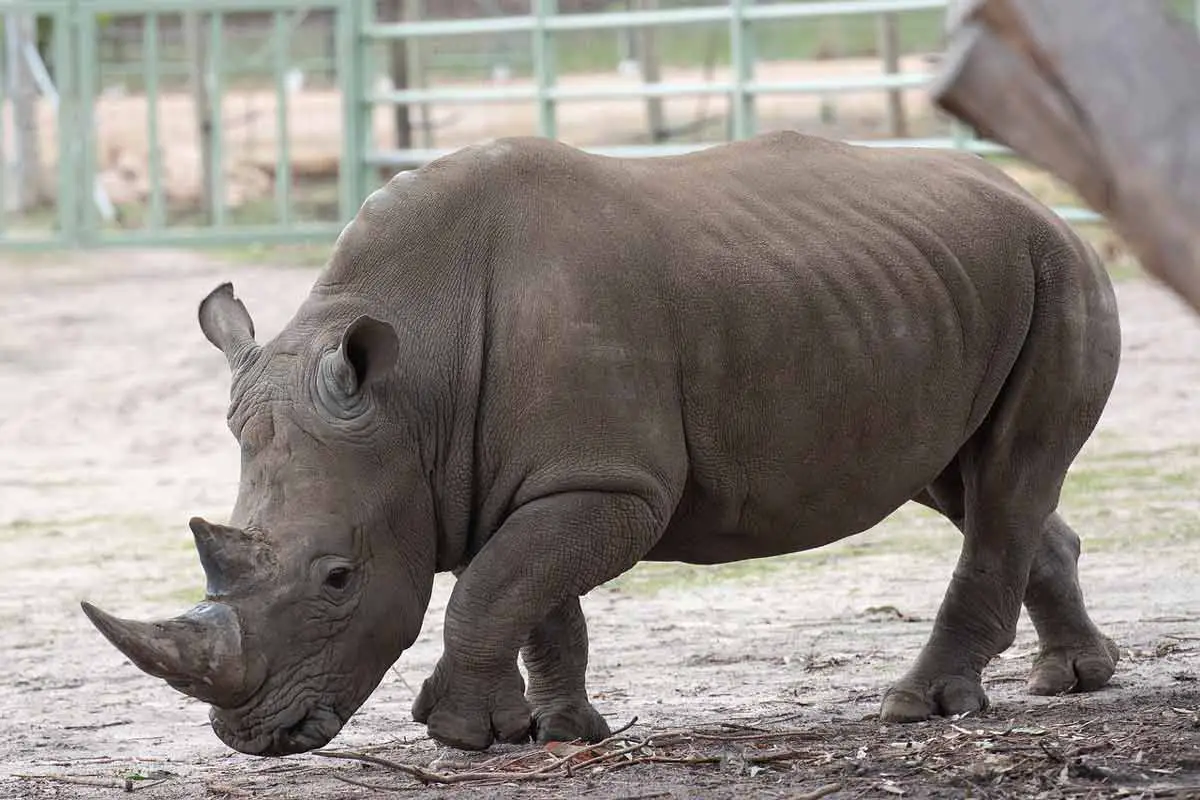
Southern White Rhino is found across high altitudes of Kenya, Zimbabwe, Namibia, and South Africa. Only 20,500 Southern White Rhinos are left.
Gone are those days when Northern White Rhinoceros used to be found. They used to live in Chad, the Central African Republic, Sudan, the Democratic Republic of the Congo, and Uganda. There are only 2 Northern white rhinos left as of 2020. They currently reside in a rhino sanctuary based in Kenya.
A bit of good news: Scientists have successfully created Northern white rhino Embryos using in-vitro fertilization. It’s a great achievement! Planting this embryo in a Southern white female rhino has not yet been achieved but hopes are high.
The Black Rhinoceros (Diceros Bicornis)
The black rhinos are native to Tanzania, Zambia, Zimbabwe, Mozambique, and some parts of South Africa. Black Rhino is much smaller than white rhinos and understandably weighs less. They are hook-lipped and sometimes have 3 horns!
A well-known subspecies of black rhinoceros is the eastern black rhinoceros which is critically endangered.
Black rhino population stands around 5500 in 2020. This is much higher than 2410, back in 1995.
The Indian Rhinoceros
Indian Rhinoceros are the bigger one-horned rhinos. They can be as big as White Rhinos.
These magnificent beasts are found in Himalayas of Pakistan, Nepal and India. They love to stay in tall grasslands and forests at the foothills of Himalayas.
India claims to have 67% of Indian rhino species contained in the Kaziranga National Park.
Javan Rhinoceros (Rhinoceros sondaicus)
With only 60 members left, Javan Rhinoceros species are one of the most endangered mammals in the world. Javan Rhino species is only found at Ujung Kulon National Park in Java, Indonesia.
We used to see them in other parts of them as well. However, they were ferociously hunted to extinction in India, Nepal, Bumra, Veitnam, Sumatra and Peninsular Malaysia.
Sumatran Rhinoceros
Sumatran Rhino is the smallest of rhinos; and hairy just like a bear. They are found in higher altitude regions of Sumatra and Borneo in Indonesia.
Only 275 Sumatran rhinos are left in this world. They are on the final edge to extinction. The Sumatran Rhino species once found throughout South East Asia are now only found in Malaysia and Indonesia.
Why are Rhinos Endangered?
Reading through the numbers of different Rhino species, you may be wondering; WHY?!
Don’t worry, we got you. Let’s dive into details of why and how rhinos have become critically endangered today.
In addition, I’ve also covered common reasons for wildlife endangerment here.
1. Rhinoceros Horn
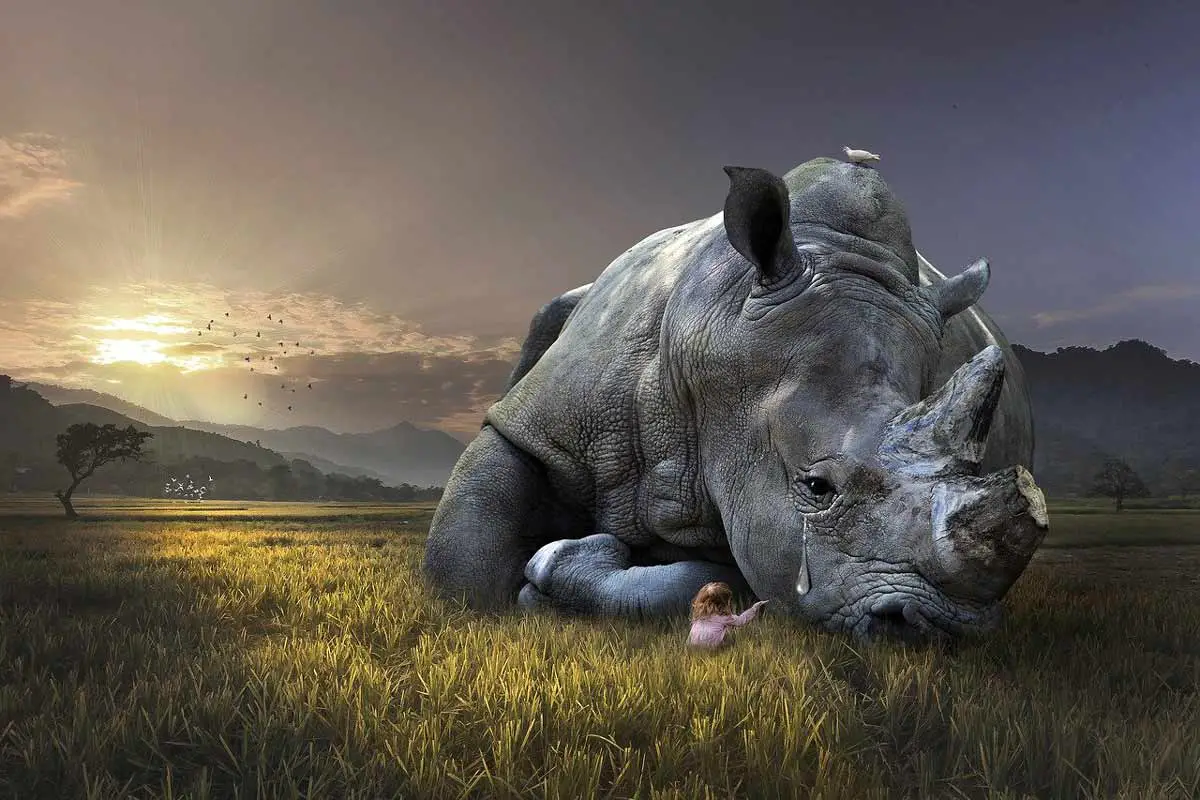
Rhinos have horns on their noses made of keratin, a protein that is found in human nails and hairs. It’s not a bone!
These horns do not have anything special but they are considered a crucial ingredient in many Eastern medicines since four millennia. No scientific studies have found any health benefits from using horns.
Although there are certain groups, mostly in the West, that believe the horns are used by Asians as aphrodisiac and sexual stimulant. These claims have been disapproved and regarded as rumors now.
Contrary to popular belief, it’s not these common beliefs that are contributing to the demand for horns in the modern times. There have been researches into this aspect as well.
They have concluded that horns have an emotional value attached to it; and many people see it as symbol of prestige and wealth. This has been strongly observed in Vietnam. How unfortunate.
2. Black Markets and Illegal Wildlife Trade
Since the 20th century, rhino horn trade has been regulated and considered illegal in many countries including China.
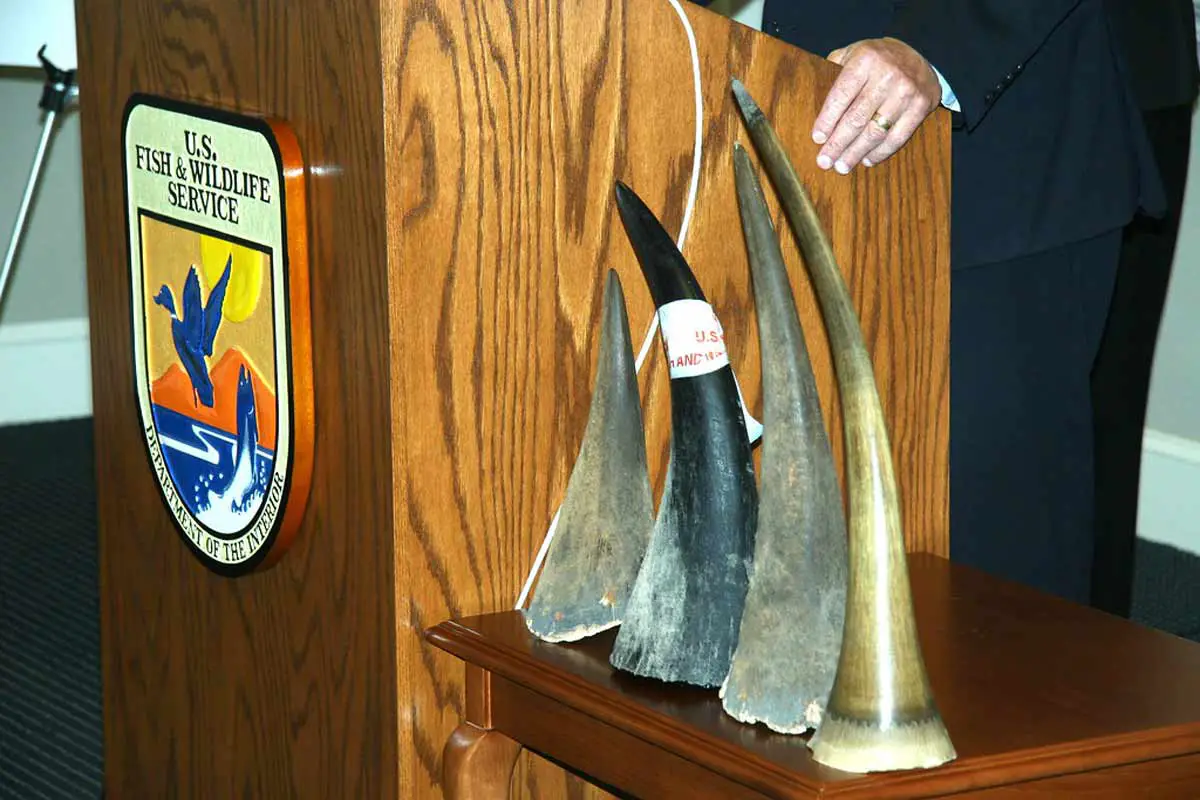
The trade of Rhino horns is strictly banned by Convention on International Trade in Endangered Species of Fauna and Flora (CITES). Sadly, many countries fail to enforce it due to corruption and bribery.
On the other hand, enforcement of these laws has had the opposite of desired effect. It significantly increased the horn prices in the black markets that have huge networks in Asia.
Currently, a single Rhino horn is valued at around $300,000 in the underground markets.
Such heavy returns combined with high demands have fueled the cartels and also attracted more people to hunt Rhinos.
Other than illegal poaching for trade of rhino products, trophy hunting is another major reason for declining numbers of the wild rhino.
3. Sophisticated Weapons

Nowadays, Rhino poaching has led to formation of a mafia that has links throughout the globe.
With such huge networks in place, the poachers have gotten access to newer and more sophisticated equipment like weapons, vehicles and helicopters.
This is a very dangerous problem, not just for the animal, but also for the rangers protecting rhinos in fields. It is now estimated that between 2007 and 2014, rhino poaching saw a dramatic increase of around 9000%.
With the Rhinos numbers falling to extinction, the prices of horns have been boosted even further leading to more efforts from poachers.
All methods to prevent poaching seem to be lagging behind the cartels at this point in time.
4. Loss of Rhino habitat
No doubt poaching is the most important factor leading to endangerment of Rhinos, but there is another aspect in play here. This factor is loss of habitat.
As the world progresses, our land demands continue to increase. Rhinos prefer to live in grasslands, wetlands and dense forests.
Unfortunately, these areas are being cleared as more space is needed for development, urbanization and most importantly; agriculture.
With loss of habitat, Rhinos are not only deprived of food and shelter but there are demographic issues as well that have recently been highlighted.
Overpopulation has also resulted in greater human-species interaction. This has pushed farmers to violently tackle rhinos competing with cattle for food. Country-side residents are also prone to act violently when they see a huge rhino.
5. Separation
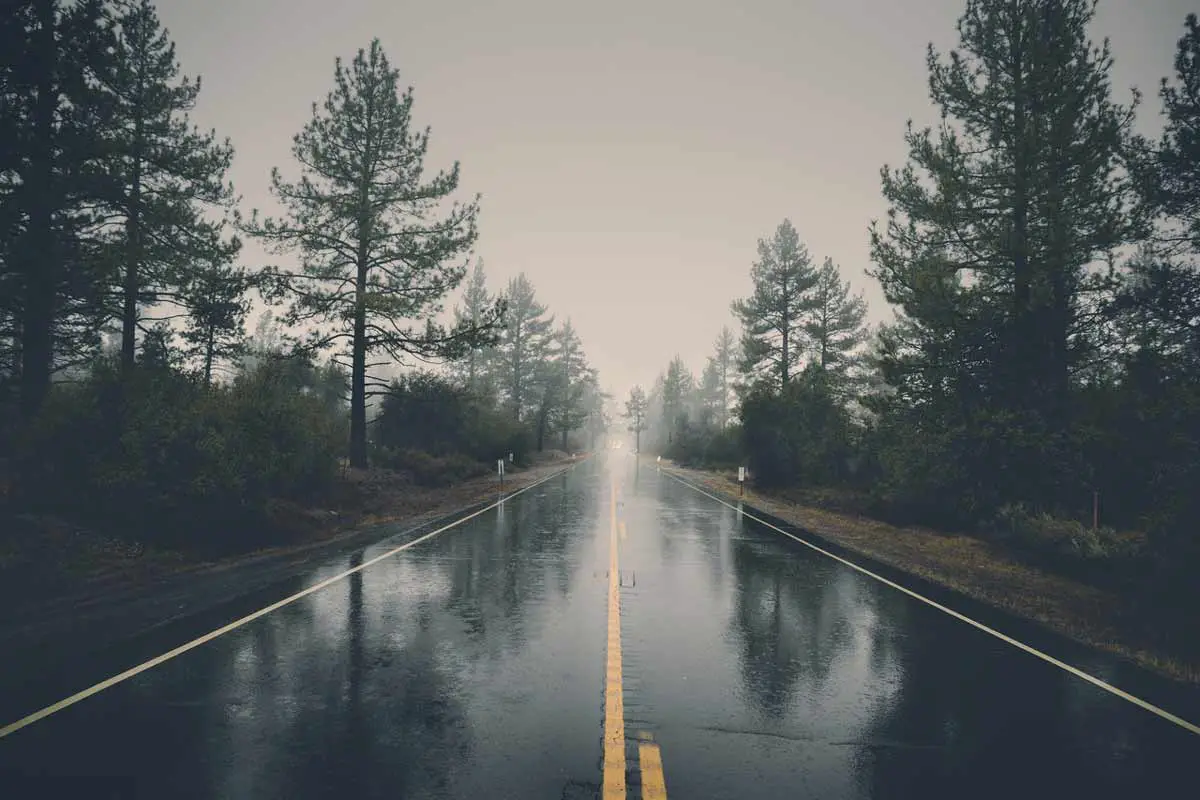
With clearing of land (for e.g. due to roads), the animals have been fragmented into smaller groups with a biased sex ratio. This has greatly impacted the chances of mating and reproducing.
Moreover, the separation has also led to unstable age distributions that have contributed to the reduced propagation of species.
Smaller populations of animals have lost a significant part of their gene pool and biodiversity. They are thus, at a disadvantage of passing genes that might negatively affect the next generations’ chances of survival.
Moreover, reducing biodiversity and in-breeding can result in diseases. This is because of weaker immune systems.
6. Climate Change
On the other hand, human activities have had a huge impact on climate change, which can lead to serious fluctuations in the weather. These fluctuations are statistically more harmful for smaller groups of animals like rhinos.
Rhinos live in cool climates and often play in mud to get rid of excess heat. Increasingly warm summers due to climate change will negatively impact their quality of life.
Increasing droughts in South Africa due to climate change are likely to impact rhinos.
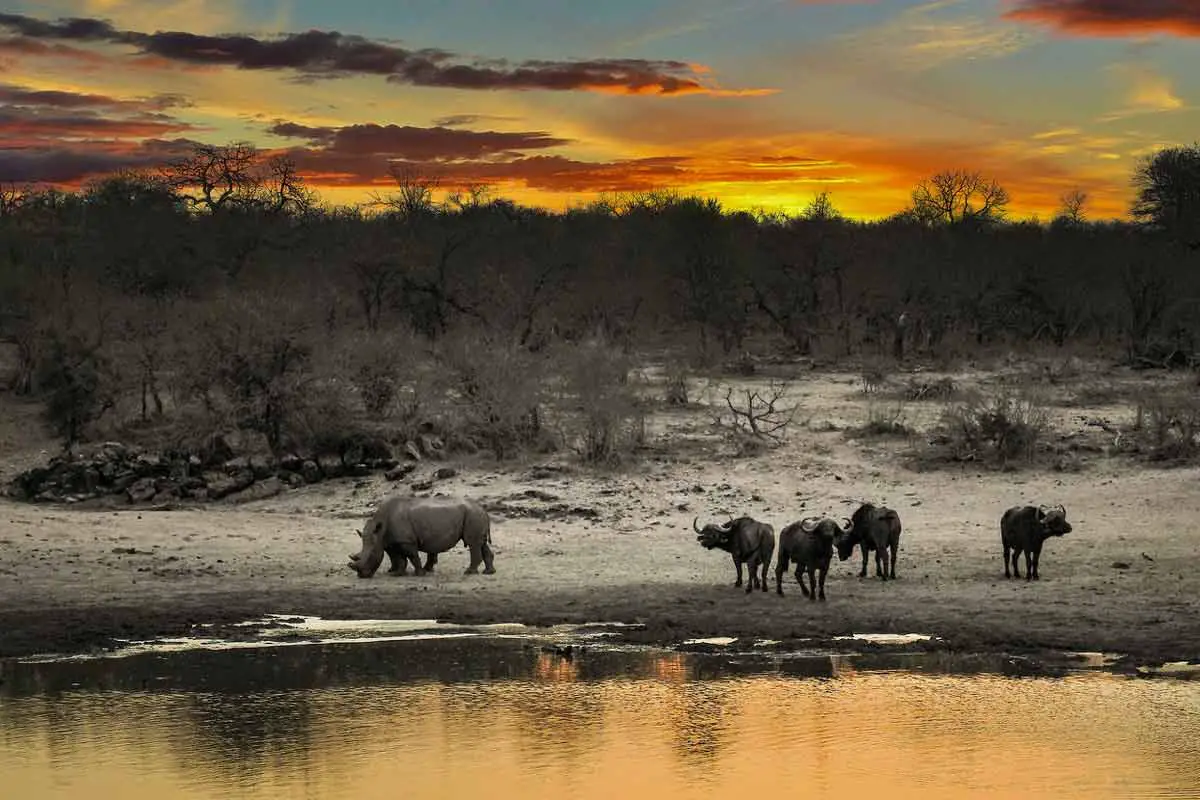
The clearing of habitat, in short, has directly and indirectly played an influential role in endangering these species.
How can we help protect Rhinos?
As we’ve discussed the reasons for endangerment of rhinos, we should also discuss how you can play an active role in saving these animals.
P.S: Remember to read these 20 ways to help protect endangered species.
1. Raise Awareness
We need to start with educating people that these animals have a lot more worth than a piece of jewelry.
If we can get the demand to subside, eventually the poachers will be dissuaded to pursue their activities.
2. Join Volunteering Programs
Join volunteering programs which aim to fight poachers and banned trade of rhino parts head-to-head. People living near to wildlife protection areas should keep an eye out for poachers and take an active part in protection of their natural heritage.
Raise awareness to report any sightings of people with hunting equipment or intent to harm those precious animals.
3. Expand Protection Areas
A cheap and effective way to improve rhino conservation is to expand the areas protected by conservancies. This often requires greater resources and manpower to maintain so the lack of funding becomes a challenge.
Conservancies are often faced with budget challenges due to reduced funding. Help them out by volunteering or donating whenever you can.
Expanding protection areas will give rhinos more space and habitat to roam around and have fun!
Finally, Land conservation and management departments should be targeted along with genomic studies to improve the breeding prospects of Rhinos and increase their population numbers quickly.
4. Building New Conservation Areas
Some of the conservancies have become too close to encroaching cities. Some of them do not have a good quality of life for animals or might be vulnerable to attacks.
This is why continuous checks should be made about these parameters. When any of these conditions appear, it’s advisable to change the location or build a new conservatory.
5. Strengthen and Enforce Laws
Rhinos are at the brink of extinction and our laws (in place since last few decades) have failed to protect them.
Moreover, law enforcement agents should be better trained and more sting operations should be conducted against the cartels operating black market networks.
